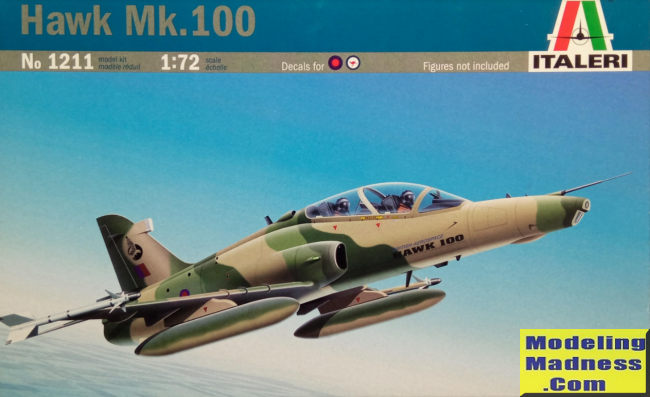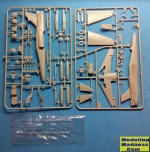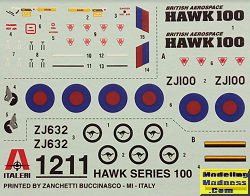
Italeri 1/72 Hawk 100
| KIT #: | 1211 |
| PRICE: | $15.00 or less |
| DECALS: | Two options |
| REVIEWER: | SpirosPendedekas |
| NOTES: |

| HISTORY |
Originated by Hawker Siddeley and subsequently produced by its successor companies British Aerospace and BAE Systems, the Hawk is a single-engine advanced trainer aircraft, possessing light attack capabilities. The Mk.100 series feature additional avionics, an optional forward looking infrared camera, a redesigned wing and hands-on stick-and-throttle controls.
| THE KIT |
 Italeri came in 1995
with their very nice 1/72 Hawk Mk.1/55/66, followed by the Mk.100 in 2000,
regularly reboxing them ever since (also a couple of times by Revell and once by
Tamiya). The specific kit is the 2010 edition of the Mk.100 version, offered as
a gift in 2023 to my sons.
Italeri came in 1995
with their very nice 1/72 Hawk Mk.1/55/66, followed by the Mk.100 in 2000,
regularly reboxing them ever since (also a couple of times by Revell and once by
Tamiya). The specific kit is the 2010 edition of the Mk.100 version, offered as
a gift in 2023 to my sons.
The kit comes in a high quality but side opening small box, carrying the same
very nice box art of the 2000 edition, depicting the company's Mk.100
demonstrator wearing "Vietnam" style camo.
Upon opening the box, I was greeted with 82 light gray styrene parts, arranged
in two equally sized sprues. Packing is nice, with the clear sprue in its
separate bag, clearly an improvement from the 2000
boxing previewed by our Editor, where all sprues were
loosely floating in the box, totally unpacked. Molding is first class, nice and
crisp without any visible flash, indicating excellent molds’ condition through
the years, with the styrene material itself being also of good quality. Panel
lines are finely recessed.
Cockpit is well represented for the scale, featuring convincing raised detail
for the instrument panels and side consoles. Though you are supposed to paint
them, it would be nice if Italeri provided instrument decals that could
optionaly be applied and succumb onto the raised instruments. The Martin-Baker
seats are also adequately represented for the scale too, featuring correct basic
shapes and molded on seat belts.
Landing gear is nicely done, but the bay innards are plain and tad on the
shallow side, a trend not uncommonly seen at 1/72 kits of those times. The
intakes feature average depth, so painting their rears black to add a sense of
depth might be a good idea. The exhaust is good looking.
Transparencies are crisply molded and clear. Instructions are well done in
typical Italeri style, coming in the form of a b/w printed pamphlet, containing
a short history of the type, a sprues map, with the construction spread in seven
basic steps, each including a few sub steps, all nice and clear, with color
callouts provided where applicable.
 Two schemes are provided, for BAe's -100 demonstrator, in "Vietnam" style camo,
but with "European" like shades (Euro 1 green, pale green and "wood" over light
ghost gray) and for RAAF’s -127 prototype variant in a very nice two tone gray,
as it stood prior to its delivery, wearing an interesting mix of Australian and
British markings. Colors are given in Model Master, F.S. codes and in generic
form. Decals are superbly printed by Zanchetti Buccinasco, expected to work
flawlessly, however I believe the Aussie decals are darker than the shade
observed in reality.
Two schemes are provided, for BAe's -100 demonstrator, in "Vietnam" style camo,
but with "European" like shades (Euro 1 green, pale green and "wood" over light
ghost gray) and for RAAF’s -127 prototype variant in a very nice two tone gray,
as it stood prior to its delivery, wearing an interesting mix of Australian and
British markings. Colors are given in Model Master, F.S. codes and in generic
form. Decals are superbly printed by Zanchetti Buccinasco, expected to work
flawlessly, however I believe the Aussie decals are darker than the shade
observed in reality.
Instructions want you to first assemble the cockpit and, together with the
exhaust, trap them between the fuselage halves. 10 grams of weight are to be
added to avoid tail sitting, I would add more for safety. The main wing and tail
planes are next, followed by the intakes, the hump aft of the cockpit and the
canopy (the latter can of course be attached, perhaps more conveniently, at
later stages).
Landing gear is next, followed by quite a few “aerodynamic” bits (like filets
and actuator fairings, with many of them having no positive locators) and
finally assembly and installation of the wing tanks and ordnance, ending a build
that, while not that complicated, will nonetheless need its systematic approach,
especially when adding all above filets and the like.
| CONCLUSIONS |
Though dating in 1995, this is still a very good
kit of the iconic Hawk: general shapes of parts look accurate, molding is crisp
with nicely done recessed panel lines, overall detail, though clearly leaving
room for improvement, is sufficient for the scale, transparencies are well done,
instructions are comprehensive and the decals are sharply printed (the RAAF
roundels are darker than should, but you can always go aftermarket).
Not that difficult to find and, in most cases, low priced, if you want to build
a 1/72 Hawk, this kit is definitely recommended.
Happy Modeling!
January 2024
Copyright ModelingMadness.com.
All rights reserved. No reproduction in part or in whole without express
permission from the editor. If you would like your product reviewed fairly and fairly quickly, please
contact the editor
or see other details in the
Note to
Contributors. Back to the Main Page
Back to the Review
Index Page
Back to the Previews Index Page